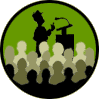%%USERNAME%% %%ACCWORDS%% %%ONOFF%% |
 |
Let's discuss poetry, With the theme of fantasy. |
Hi, I am PandaPaws and this is the first in a series of Poetry Workshop Lessons for the FSFS. Over the next eight weeks we will review poetic devices and several poetry forms. There will be an assignment at the end of each lesson, but don't worry you don't have to do them all to participate (but they will help). The final week you will be choosing your favorite form and crafting your own Fantasy/Science Fiction poem. Because you are all familiar with the basics of Fantasy and Science Fiction, I will only be discussing poetry basics in the workshop. Lesson One - Poetic Devices... These are different writing strategies poets use to breathe life into their work. We will be reviewing a few of them but know that there are many more you can employ and they will make your pieces come alive. 1) Alliteration and its cousins consonance and assonance. a)Alliteration is derived from Latin’s “Latira”. It means “letters of alphabet”. It is a stylistic device in which a number of words, having the same first consonant sound, occur close together in a series. Consider the following examples: But a better butter makes a batter better. A big bully beats a baby boy. Both sentences are alliterative because the same first letter of words (B) occurs close together and produces alliteration in the sentence. An important point to remember here is that alliteration does not depend on letters but on sounds. So the phrase not knotty is alliterative, but cigarette chase is not. http://literarydevices.net/alliteration/ b)Assonance takes place when two or more words close to one another repeat the same vowel sound but start with different consonant sounds. For instance, “Men sell the wedding bells.” The same vowel sound of the short vowel “-e-” repeats itself in almost all the words excluding the definite article. The words do share the same vowel sounds but start with different consonant sounds unlike alliteration that involves repetition of the same consonant sounds. http://literarydevices.net/assonance/ c)Consonance refers to repetitive sounds produced by consonants within a sentence or phrase. This repetition often takes place in quick succession such as in pitter, patter. It is classified as a literary term used in both poetry as well as prose. For instance, the words chuckle, fickle, and kick are consonant with one and other due to the existence of common interior consonant sounds (/ck/). The literary device of consonance is inherently different from assonance which involves the repetition of similar vowel sounds within a word, sentence, or phrase. Another distinction to be appreciated is that of between consonance and rhyme. In the case of rhyme, consonant sounds can be present at the beginning, middle, or end of several successive words, rather than merely at the ends of words. Further, the device of consonance needs to be distinguished from alliteration. In contrast to alliteration, consonance involves repetition of consonant sounds only. http://literarydevices.net/consonance/ 2) Imagery This is the art of "showing" rather than "telling". It also involves descriptive wording. Instead of describing a pet as a bird, you can be more descriptive by stating it is a budgie. The more descriptive you are, the better the picture you paint for your reader. Using active verbs in your writing is another way to add imagery to your pieces. An example, I was given in a class I took on this site was replacing the phrase "destruction of the homes by fire" with the phrase "fire destroyed the homes". Another example would be using the phrase "soldiers battled fiercely" instead of "the men fought". When you write a poem let it sit for a while and then go back and see if any of your phrases or lines could be rewritten more 'actively'. 3) Simile and Metaphor Simile- noun 1. a figure of speech in which two unlike things are explicitly compared, as in “she is like a rose.”. Compare metaphor. http://dictionary.reference.com/browse/simile Metaphor noun 1. a figure of speech in which a term or phrase is applied to something to which it is not literally applicable in order to suggest a resemblance, as in “A mighty fortress is our God.”. Compare mixed metaphor, simile (def 1). http://dictionary.reference.com/browse/metaphor ASSIGNMENT- 1)Write four examples of alliteration, consonance or assonance. 2)Add imagery to the following sentences- She was tired. The plant died. It was warm. 3)Write two sentences each using examples of simile and metaphor. |